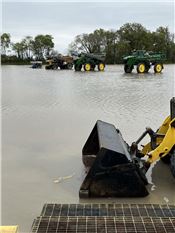Periodic Rainfall, Saturated Soils Lead To Planting Delays

Equipment standing in water after a deluge April 20, 2022, near Tuckerman, Arkansas.
Image courtesy Randy Chlapecka
TRACY COURAGE AND RYAN MCGEENEY
LITTLE ROCK, ARKANSAS
After a rainy April, spring planting in Arkansas is off to a slow start, with three of the state’s major crops lagging far behind their typical progress.
Jarrod Hardke, extension rice agronomist for the University of Arkansas System Division of Agriculture, said it could be May 1 before some areas of the state are dry enough to resume planting – or even later, with additional rainfall in the forecast.
Without a little cooperation from Mother Nature, he said, 2022 could be the first year that the state’s rice acreage falls below 1 million acres in nearly 40 years.
As of April 25, 14 percent of Arkansas’ estimated rice acreage had been planted, compared with the five-year average of 48 percent for this time of year, according to the U.S. Department of Agriculture’s National Agricultural Statistics Service. One of the brighter spots in the state’s rice planting efforts, Hardke said, has been the Stuttgart area in eastern Arkansas.
“They’ve been luckier than most,” he said. “The rest of the state has little planted to speak of. It’s been extremely wet.”
During the week of April 18-24, about half of the soil throughout Arkansas was saturated to about 25-30 percent, according to NASS. The remaining half was saturated to about 50 percent. While there is no “absolute line” determining when fields are too wet to work, saturated soils can make for a tough slog in a tractor.
Arkansas rice accounts for more than 47 percent of total U.S. rice production. Currently, rice is grown in 40 of the state’s 75 counties, primarily in the eastern half of the state. Arkansas has consistently harvested more than one million acres since 1983.
Last year, Arkansas rice producers harvested nearly 1.2 million acres, down from 1.4 million acres in 2020.
“The number of acres expected to be planted continues to drift down,” Hardke said. “The best scenario, before the year started, was that we would hit 1.2 million acres. Current indications are that we’ll come in well below that.”
Soybean struggles
Many Arkansas soybean growers have also struggled to get seeds in the ground this year, although, statistically, they’ve had an easier go than rice growers. As of last week, NASS reported about 12 percent of the state’s estimated 3 million soybean acres had been planted.
Jeremy Ross, extension soybean agronomist for the Division of Agriculture, said that while the delays are frustrating, it’s not time to panic just yet.
“Everybody’s antsy to get planted,” Ross said. “We haven’t had much decent weather and haven’t been able to get a whole lot done this spring.
“But we’re still ok,” he said, adding that concerns over yield decline – often a consequence of increasingly late planting as summer approaches – are still premature.
“As of right now, we really don’t have any kind of yield decline,” Ross said. “But give it another three to four weeks, and we will start to see yields declining if we can’t get planted.”
Other crops
Corn is also expriencing delays. According to NASS, only 35 percent of the state's planned plantings are in the gsround. That's well off last year's 66 percent pace and the 67 percent five-year average.
Cotton and peanuts are in their early stages. Cotton is 2 percent planted, which is the same as last year and just off the 3 percent five-year average. Peanuts are also at 2 percent, a little behind last year's 4 percent and the 6 percent five-year average.
Wild weather
Arkansas farmers are no strangers to weather delays, but they’ve had more than their fair share in recent years: 2019 had excessive rain and then flooding from Hurricane Barry in July. More flooding came in June 2021, when 18-20 inches of rain fell in Desha County, prompting a state of emergency.
“From fall of 2019 through now, there’s been a fair amount of insanity for those kinds of events,” Hardke said. “This year almost feels the same.”
“It’s similar to the pattern we saw last year,” Ross said.
“We’d get one or two days where we could get out in the fields, but then comes another round of rainfall, so we’re out of the field another three to five days.”
Though planting is behind schedule, there’s still time to catch up.
Most rice farmers aim to finish planting rice by early May, so they can focus on planting soybean. Late planted rice is still an option, though there is also a lower yield expectation, Hardke said.
“We can cover a lot of ground very fast with the equipment we have,” Hardke said. “If you get a full two-week dry window, you can virtually plant the whole state soybean crop, running nonstop. The same is true for rice, but when does that window arrive, and which crop gets priority?” ∆
TRACY COURAGE AND RYAN MCGEENEY: University of Arkansas